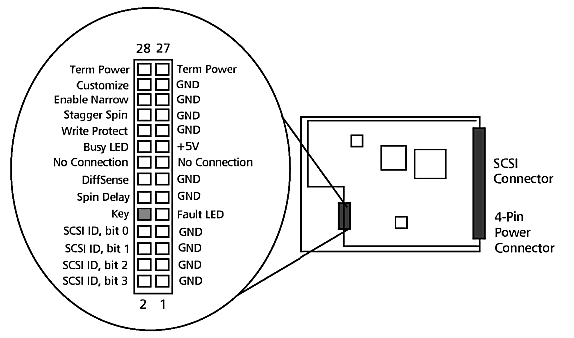[ The PC Guide | Systems and Components Reference Guide | Hard Disk Drives | Construction and Operation of the Hard Disk | Hard Disk Connectors and Jumpers ]
SCSI Configuration Jumpers
SCSI hard disks have more sophisticated controllers than their IDE/ATA cousins, and as a result typically have many more jumpers that can be set to control their operation. They also tend to vary much more from manufacturer to manufacturer, and from model to model, in the number and types of jumpers they have. Typically the following are the most common and important SCSI drive jumpers:
- SCSI Device ID: Every device on a SCSI bus must be uniquely identified for addressing purposes. Narrows SCSI drives will have a set of three jumpers that can be used to assign the disk an ID number from 0 to 7. Wide SCSI drives will have four jumpers to enable ID numbers from 0 to 15. Some systems don't use jumpers to configure SCSI device IDs.
- Termination Activate: The devices on the ends of the SCSI bus must terminate the bus for it to function properly. If the hard disk is at the end of the bus, setting this jumper will cause it to terminate the bus for proper operation. Not all drives support termination.
- Disable Auto Start: When present, this jumper will tell the drive not to automatically spin up when the power is applied, but instead wait for a start command over the SCSI bus. This is usually done to prevent excessive startup load on the power supply. Some manufacturers invert the sense of this jumper; they disable startup by default and provide an "Enable Auto Start" jumper.
- Delay Auto Start: This jumper tells the drive to start automatically, but wait a predefined number of seconds from when power is applied. It is also used to offset motor startup load on systems with many drives.
- Stagger Spin: An "enhanced version" of "Delay Auto Start". When a system with many hard drives has this option set for each unit, the drives stagger their startup time by multiplying a user-defined constant times their SCSI device ID. This ensures no two drives on the same SCSI channel will start up simultaneously.
- Narrow/Wide: Some drives have a jumper to control whether they will function in narrow or wide mode.
- Force SE: Allows newer Ultra2, Wide Ultra2, Ultra160, Ultra160+ or other LVD SCSI drives to be forced to use single-ended (SE) operation instead of low voltage differential (LVD).
- Disable Parity: Turns off parity checking on the SCSI bus, for compatibility with host adapters that don't support the featurer.
|
Option header block signals and functions for the Quantum Atlas 10K SCSI drive. |
Original image � Quantum Corporation |
This is list is not intended to be exhaustive; many SCSI drives have additional special features that are enabled through more jumpers. Some drives have replaced some of their jumpers with software commands sent over the SCSI interface. SCSI jumpers are often clustered together into what is called an option block. See here for details on SCSI hard disk setup.
![]() Next: LED Connector
Next: LED Connector
| The PC Guide
(http://www.PCGuide.com) Site Version: 2.2.0 - Version Date: April 17, 2001 © Copyright 1997-2004 Charles M. Kozierok. All Rights Reserved. |
Not responsible for any loss resulting from the use of this site. Please read the Site Guide before using this material. |
